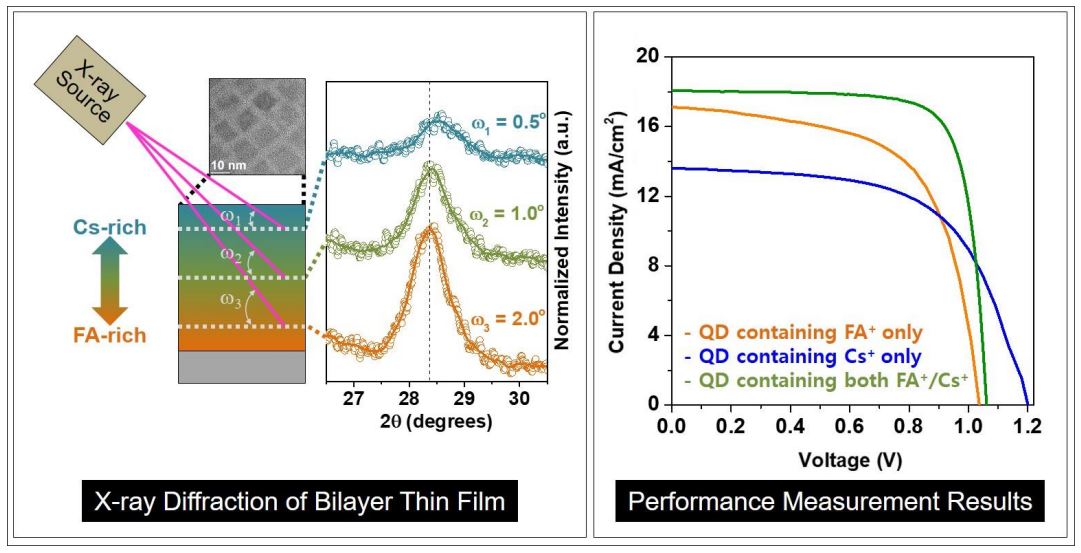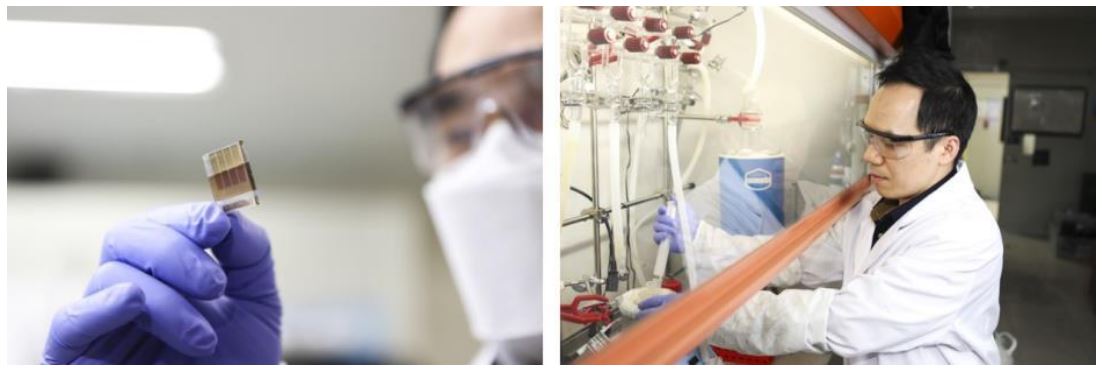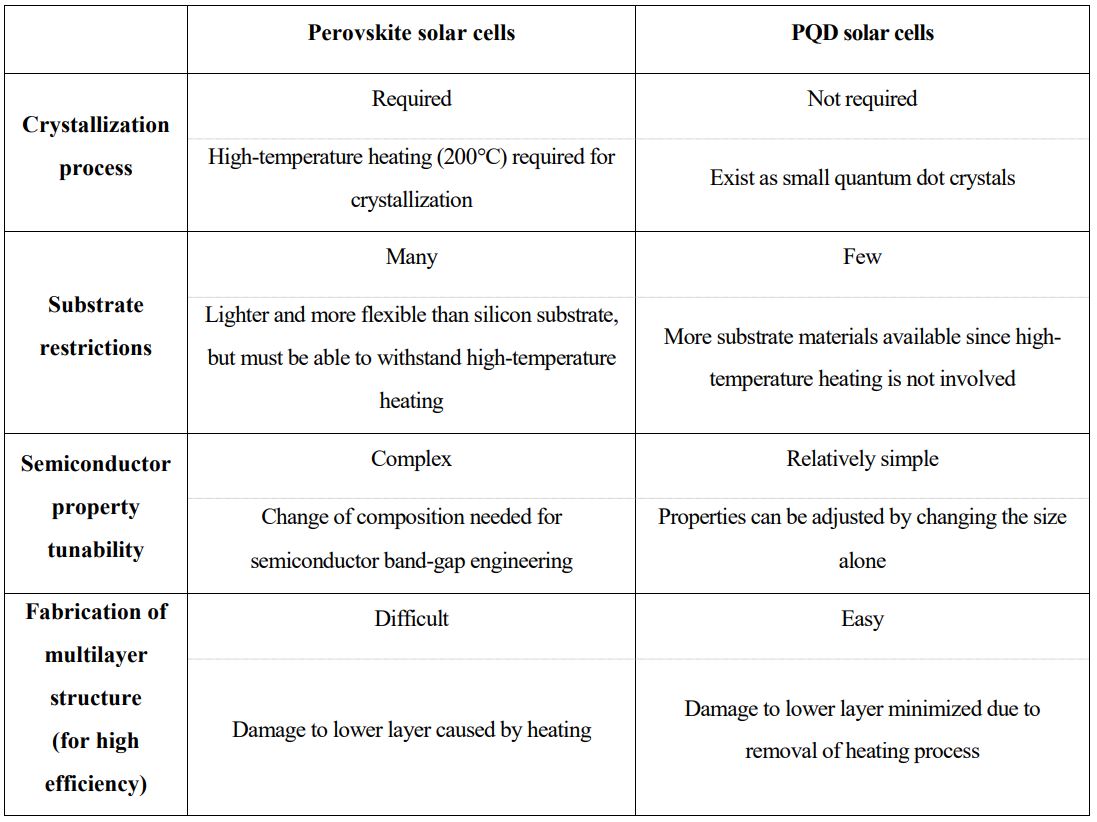
- Created2021.04.05
Perovskite quantum dot solar cells deliver maximum stabilityand efficiency
-KIMM’s Department of Applied Nanomechanics achieves efficiency of 16% after 1000 h in ambient storage-
The Korea Institute of Machinery & Materials (KIMM; President Sang Jin Park) under the Ministry of Science and ICT announced a new technique of manufacturing Perovskite Quantum Dot (PQD) solar cells that offer the world-class efficiency and stability in ambient conditions.
Dr. Hyung Cheoul Shim, senior researcher of the Department of Applied Nanomechanics at KIMM, succeeded in creating solar cells that maintain an efficiency of 16% for up to 1,000 hours in ambient storage using the cation exchange reaction occurring in the bilayer thin film of PQD solar cells.
Light-absorbing layers in solar cells have different band-gaps, and thus vary in their ability to absorb light of different wavelengths from ultraviolet to infrared. Various attempts have been made to stack several semiconductor materials, so as to obtain lightabsorbing layers with wide spectral ranges.
The fabrication of perovskite quantum dot solar cells is also relatively simple. Existing perovskite solar cells are obtained by coating substrates with a perovskite precursor followed by crystallization at a temperature of at least 200 °C. On the other hand, perovskite quantum dot solar cells can be made by coating with colloidal nanocrystal quantum dots solution on a substrate without post heat treatment.
The research team fabricated PQD solar cells having a bilayer structure composed of two different cations (cesium and formamidinium lead iodide compounds). During the process of making the PQD thin film, defects may occur inside the solar cell through the ligand removal process. The team designed the cells such that defects are reduced through the movement of formamidinium ions. As such, the proposed PQD solar cells were able to maintain performance for a longer time than typical single-layer light absorbers.
The new technology is expected to significantly lower manufacturing costs as it eliminates the heating process for light-absorbing layers in solar cells. Because perovskite is lighter and more flexible than silicon, perovskite solar cells can be used to supply power in areas where conventional solar cells are difficult to install. They can enhance overall system efficiency by reinforcing light absorbers in silicon solar cells. Moreover, the use of quantum dots with minimal defects due to cation exchange improves the atmospheric stability of solar cells without the need for a separate coating or encapsulation.
Dr. Hyung Cheoul Shim, senior researcher of KIMM, said, “The PQD solar cells have a simple manufacturing process, and offer both efficiency and stability. Through followup studies, we hope to further enhance the value of solar cells, and contribute to Korea’s goal of going carbon neutral.”
[List of Attachments] - Attachment 1: Bilayer thin film of PQD solar cell (graph) - Attachment 2: PQD solar cell prototype (photo) - Attachment 3: Comparison of perovskite solar cells and PQD solar cells (table)
The Korea Institute of Machinery and Materials (KIMM) is a non-profit governmentfunded research institute under the Ministry of Science and ICT. Since its foundation in 1976, KIMM is contributing to economic growth of the nation by performing R&D on key technologies in machinery and materials, conducting reliability test evaluation, and commercializing the developed products and technologies.
The study was supported by the “Omni-Tex Manufacturing Technology Development Program” of KIMM under the Ministry of Science and ICT, “Development of Technology for High-efficiency and Low-cost Solar Cells Based on Quantum Structures” by the Ministry of Trade, Industry and Energy, and the “Alchemist Project for Development of Soft Smart Suit Capable of Rapid Detection and Blocking of Harmful Substances”. The results were published under the title “Highly Efficient and Air-Stable Heterostructured Perovskite Quantum Dot Solar Cells Using a Solid-State Cation-Exchange Reaction” in Volume 12, Issue 51 of ACS Applied Materials and Interfaces.
Credit : The Korea Institute of Machinery and Materials (KIMM)
Usage Restrictions of Multimedia (Attachment File) : The sources of photos and research results from KIMM must be specified.
-Attachment 1: Bilayer thin film of PQD solar cell (graph)

Image description:
(Left) The image shows the X-ray diffraction of a PDQ solar cell fabricated by KIMM. Hyung Cheoul Shim, senior researcher of the Department of Applied Nanomechanics at KIMM, observed the cross-section of a solar cell with a bilayer thin film composed of cesium lead iodide (blue) and formamidinium lead iodide (orange) perovskite quantum dots, and found a new feature (green) resulting from the mixing of cations at the thin film boundaries.
(Right) Dr. Hyung Cheoul Shim, senior researcher of the Department of Applied Nanomechanics at KIMM, analyzed the X-ray diffraction results of the bilayer comprised of cesium and formamidinium lead iodide, and showed that the newly created middle layer (green) allows the perovskite solar cell to have superior performance compared to existing solar cells in terms of voltage and current.
-Attachment 2: PQD solar cell prototype (photo)

Photo description:
(Left) PQD solar cell developed by the Department of Applied Nanomechanics at KIMM.
(Right) Dr. Hyung Cheoul Shim, senior research of the Department of Applied Nanomechanics at KIMM, demonstrates the synthesis of a PQD solution.
-Attachment 3: Comparison of perovskite solar cells and PQD solar cells (table)




